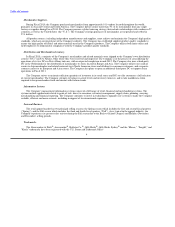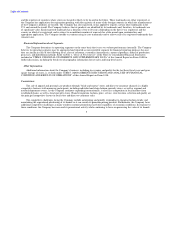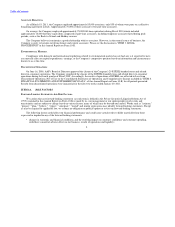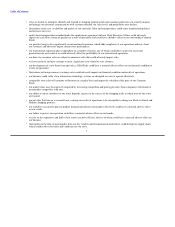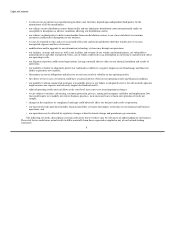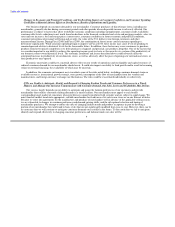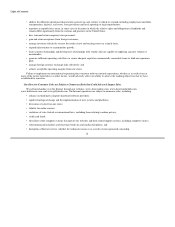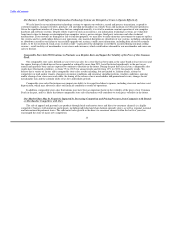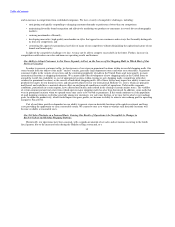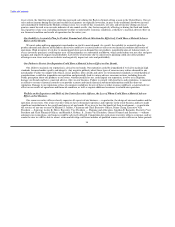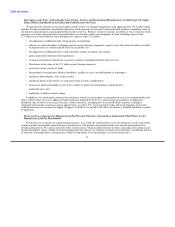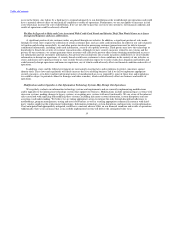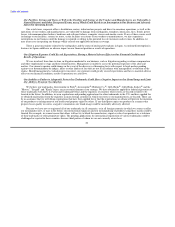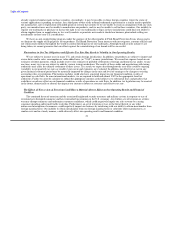Abercrombie & Fitch 2010 Annual Report Download - page 17
Download and view the complete annual report
Please find page 17 of the 2010 Abercrombie & Fitch annual report below. You can navigate through the pages in the report by either clicking on the pages listed below, or by using the keyword search tool below to find specific information within the annual report.
Table of Contents
Our Business Could Suffer if Our Information Technology Systems are Disrupted or Cease to Operate Effectively.
We rely heavily on our information technology systems to operate our websites, record and process transactions, respond to
customer inquiries, manage inventory, purchase, sell and ship merchandise on a timely basis and maintain cost-efficient operations.
Given the significant number of transactions that are completed annually, it is vital to maintain constant operation of our computer
hardware and software systems. Despite efforts to prevent such an occurrence, our information technology systems are vulnerable
from time-to-time to damage or interruption from computer viruses, power outages, third-party intrusions and other technical
malfunctions. If our systems are damaged or fail to function properly, we may have to make monetary investments to repair or replace
the systems and we could endure delays in our operations. Any material disruption or slowdown of our systems, including a disruption
or slowdown caused by our failure to successfully upgrade our systems, could cause information, including data related to customer
orders, to be lost or delayed. Such a loss or delay could – especially if the disruption or slowdown occurred during our peak selling
seasons – result in delays of merchandise to our stores and customers, which could reduce demand for our merchandise and cause our
sales to decline.
Comparable Store Sales Will Continue to Fluctuate on a Regular Basis and Impact the Volatility of the Price of Our Common
Stock.
Our comparable store sales, defined as year-over-year sales for a store that has been open as the same brand at least one year and
the square footage of which has not been expanded or reduced by more than 20%, have fluctuated significantly in the past on an
annual and quarterly basis and are expected to continue to fluctuate in the future. During the past three fiscal years, comparable sales
results have fluctuated as follows: (a) from 7% to (23)% for annual results and (b) from 13% to (30)% for quarterly results. We
believe that a variety of factors affect comparable store sales results including, but not limited to, fashion trends, actions by
competitors or mall anchor tenants, changes in economic conditions and consumer spending patterns, weather conditions, opening
and/or closing of our stores near each other, the timing of the release of new merchandise and promotional events, changes in our
merchandise mix and the calendar shifts of tax free and holiday periods.
Comparable store sales fluctuations may impact our ability to leverage fixed direct expenses, including store rent and store asset
depreciation, which may adversely affect our financial condition or results of operations.
In addition, comparable store sales fluctuations may have been an important factor in the volatility of the price of our Common
Stock in the past, and it is likely that future comparable store sales fluctuations will contribute to stock price volatility in the future.
Our Market Share May be Negatively Impacted by Increasing Competition and Pricing Pressures from Companies with Brands
or Merchandise Competitive with Ours.
The sale of apparel and personal care products through brick-and-mortar stores and direct-to-consumer channels is a highly
competitive business with numerous participants, including individual and chain fashion specialty stores, as well as regional, national
and international department stores. The substantial sales growth in the direct-to-consumer channel within the last few years has
encouraged the entry of many new competitors
14


